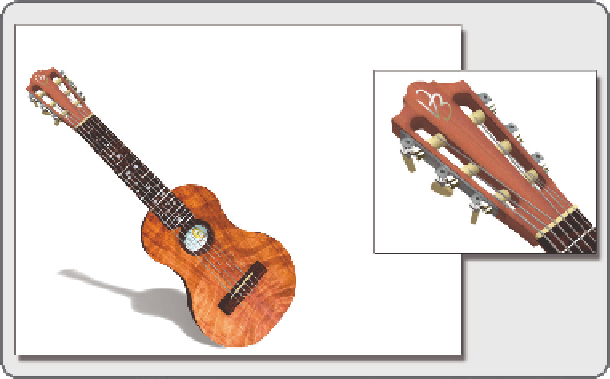Game Development Reference
In-Depth Information
FIGURE 6.3
A virtual “guitarlale” built entirely from inworld prims. Created by Vicki Brandenburg in Second Life
circa 2009. Inset shows the level of detail in the head and tuning pegs that she achieved.
with import/export and supports the “Build It Once” approach for your project. It is also conceivable that the
imported mesh objects will have less “land impact” on the virtual region and will render more quickly if they
were built for a real-time rendering environment and have made eficient use of their faces and vertices. The
downside of Scenario 2 is that it may take longer to create as you will be making 50% of the textures and
geometry from scratch, and it will require the real-world expense in Linden dollar “upload fees” if you are
bringing the meshes into Second Life.
6.2.1.3 Scenario 3: The “90/10” Approach
The “90/10” approach is the most complex and most expensive scenario of the three. In this scenario, 90%
of the 3D geometry is created from external meshes, and all related textures include lighting and baking of
shadows for each speciic object. This is a professional level and requires a serious commitment to learning
the 3D modeling software you have chosen. Again, this could allow for eficient object construction if built
properly, which would lessen land impact and increase real-time rendering speeds. This approach also fully
supports the “Build It Once” method because the models are usable in many programs, platforms, worlds,
or games. If you want to proceed this way, you would be well advised to take a class in 3D modeling or at
least do many tutorials for the software of your choice if you have not been trained on 3D modeling software
previously. It will lower your frustration level considerably.
Whatever scenario you choose, make sure that the rest of the team is on board with the decision, and that
you clearly delineate where each major element in your design will originate. You may ind it helpful to do a
rough model of the build in SketchUp irst just to get a sense of the scale of the effort that will be required.
6.3 BUILDING WITH THE INWORLD PRIMS (PRIMITIVE OBJECTS)
If you choose Scenario 1 for a project, the seven-member family of prims—the box, cylinder, sphere, prism, torus,
ring and tube—is all you will use to build your virtual world. Lots of possibilities open up once you understand
how they can be carved, cut, and twisted into various forms. In the Firestorm Viewer, there is a whole suite of Edit
modiiers available for each prim. Let's go through each one and see what kinds of diverse forms can be made.
Feel free to open up your viewer, ind a virtual sandbox somewhere, and build these as they are shown below.

